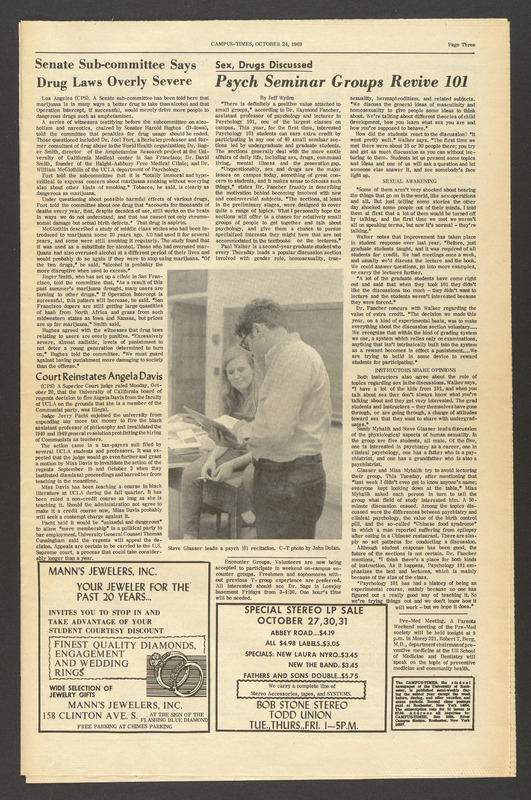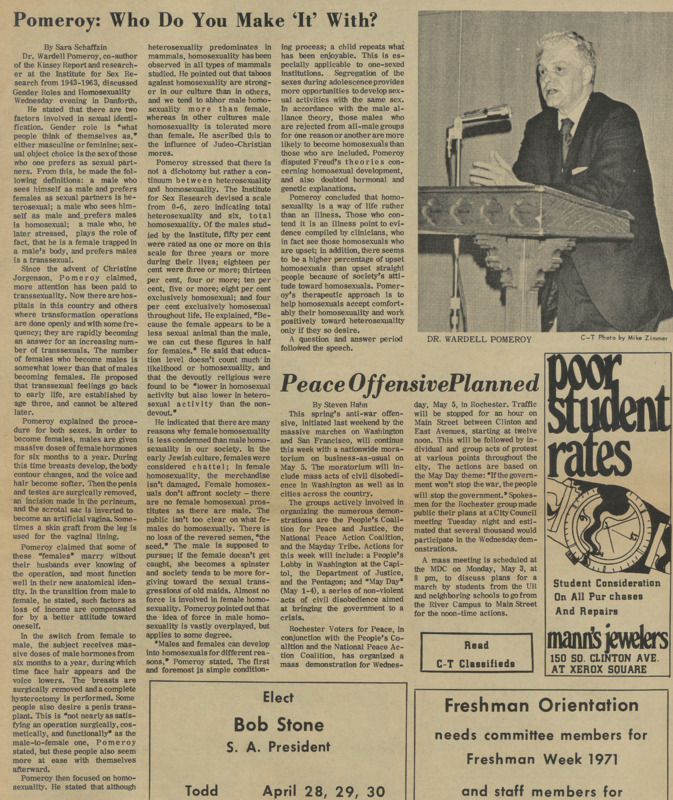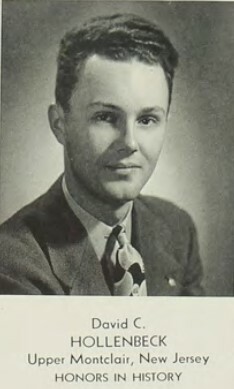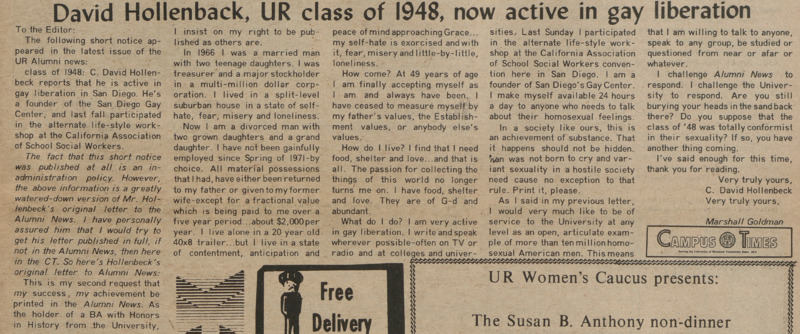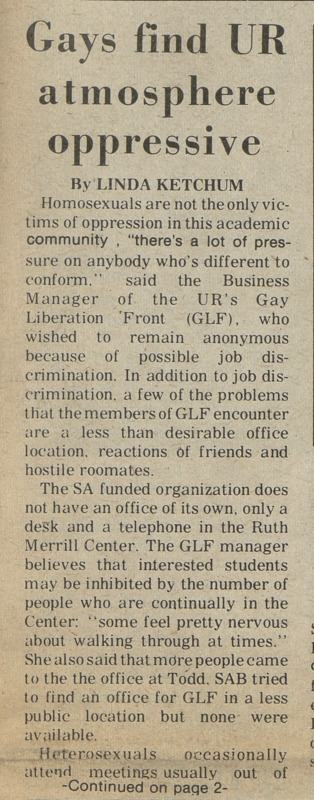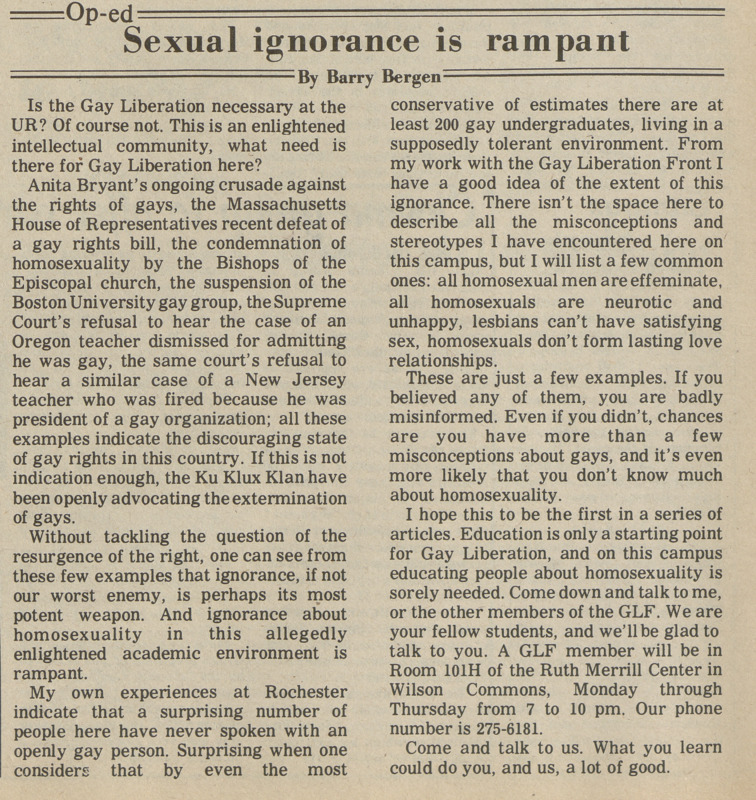1970s
The early days of the Gay Liberation Front in Rochester are frequently remembered and cited as the beginning of LGBTQ+ life and activism at the University.[9] A commonly used symbol or moment to mark the ‘beginning’ of this history becoming visible is one fateful classified ad placed in the Spring of 1970. Nearing a year after Stonewall, which had sparked ripples of liberation movements across the country, students were determined to bring gay liberation to Rochester. The simple but memorable ad read, “Take heart brothers, Gay Lib is coming.” While this, of course, was an essential moment- one could also start the history seven months prior, in October of 1969. An article printed in the Campus Times describes the content of a Psychology seminar group. In conjunction with the Psychology 101 course, second-year graduate student Paul Walker led discussions on subjects such as gender roles, homosexuality, and transsexuality. These discussions were optional, taken for extra credit, and seemed to be well-received by the students who attended. The open discussion and education of these subjects would be the first in a long career for Paul Walker. He would give occasional lectures on the psychology behind homosexuality to the Rochester Gay Liberation Front or the university’s Sexual Education Committee. Walker continued to teach about such topics within the Psychology department until the completion of his degree. [10] After finishing his doctorate at the University of Rochester in 1976, Paul Walker went on to be a renowned openly gay psychologist, well-known and admired by the early trans community.[11] He served as the president of the Harry Benjamin International Gender Dysphoria Association, now known as the World Association for Transgender Health. [12] Walker also helped Lou Sullivan, beloved transgender activist, advocate for gay transgender individuals. [13] Unfortunately, AIDS cut his life and career tragically short. Walker passed away in the fall of 1991 but his influence is still felt today and should be remembered.
Starting GLF
In May 1970, a student placed a brave classified ad in the Campus Times. Larry Fine, the soon-to-be co-founder of the Gay Liberation Front wrote, “Take heart brothers, Gay Lib is coming!” That promise was delivered in the fall with the help of graduate student Bob Osborn. [14] The first meeting of the Rochester Gay Liberation Front (GLF) met on October 3rd, 1970 in the Todd Union music room. Guest speakers from Buffalo and Cornell gay organizations came to talk at this inaugural meeting. The group hosted weekly meetings throughout the academic year and soon began to hold dances to spread visibility. The GLF soon started a newsletter, The Empty Closet, which allowed access to information about gay liberation to spread on and off campus.
First Year of Gay Liberation
The spring of 1971 brought Wardell Pomeroy, famed American Sexologist and co-author of the Kinsey Report, to speak to the University. This talk was hosted by the Sex Education Committee which frequently collaborated with the Gay Liberation Front. An overview of the talk published in the Campus Times shows that the subject matter surrounded gender roles and homosexuality diving also into transsexuality. This once again shows trans identities being discussed far earlier than people realize, intertwined with the history of Gay Liberation at the university. Over the years, many important names in LGBTQ+ activism have been invited to speak to students at the University of Rochester. These speakers increased awareness and education on the identities they represented which introduced new perspectives to the campus community.
Only weeks after Pomeroy's visit, in the final days of the GLF's first academic year, Eastman School of Music students brought to light the intense homophobia facing their peers. Flora Burton, Dean of Students at Eastman, is cited in a letter titled “Gay Freedom” as having tormented gay students, threatening blackmail and targeting them based on their sexualities. The letter revealing the conditions suffered by gay Eastman students demanded justice and safety in their place of education. These students stood up against the administration by drawing attention to the issues at hand. This was one of the first of many battles LGBTQ+ students fought on campus over the years. The Gay Liberation Front started a precedent of activism in the face of injustice that would remain ingrained in the University of Rochester students for decades to come.
GLF splits in Two
While the GLF held steady numbers in attendance the majority of members and meeting attendees were community members - not students. In the Spring of 1973 the Gay Liberation Front underwent restructuring. The group made the decision to separate into two factions: a student group on campus and a community group off campus. Though membership of GLF had been high in the first years, only a handful of the members were University of Rochester students. As of December 1971, there were 12 students among roughly 200 members. [15] This created an odd dynamic, especially with either faction needing different support and holding different goals. While many older community members were ready to jump into political action, many gay students were still coming to terms with their identity. There was also a fear that so many outside members were scaring away students from coming out and attending meetings, overwhelmed by unfamiliar crowds of non college aged students. This left the gay liberation front on campus to the dedicated students, while the community members branched off into various groups unified under the name Gay Alliance of Geneesee Valley (GAGV). [16]
C. David Hollenbeck
Charles David Hollenbeck attended the University of Rochester in the 1940s, seeking a BA in History. He was a diligent student, active in theater and Greek life. His time at the University was interrupted by his duty, going to war as an army medic, but he returned and graduated in the class of 1948. After graduation, he pursued a study abroad opportunity in Paris, through which he found a wife. They went on to be married and have two daughters who were raised bilingual, in English and French. This seems an average enough, traditional life and love story. Things are not always as they seem on paper. In 1974 Hollenbeck wrote a letter which was published in the Campus Times, declaring that the updates he had sent to the alumni newsletter had been neglected and watered down. Why, one might ask? C. David Hollenbeck had left his family, uprooted his life, and moved to San Diego to fight for gay rights after coming out himself.
The UR Alumni News abridged his life story, publishing:
“Class of 1948: C. David Hollenbeck reports that he is active in gay liberation in San Diego. He’s a founder of the San Diego Gay Center, and last fall participated in the alternate life-style workshop at the California Association of School Social Workers.”
It is somewhat impressive that the administration, after months of ignoring Hollenbeck, printed anything to do with an alumnus’ work with Gay Liberation. This is noted in the Campus Times letter submitted by a student of the GLF. However, the published blurb diminishes his accomplishments, especially as he had to submit his updates multiple times to receive any recognition. His letter which is published in the Campus Times speaks of the bravery and sacrifice of his journey to coming out. He describes turning his losses into help for others facing similar struggles. He preaches about the importance of acceptance and liberation for gay individuals. His visibility as an openly gay alumnus from 1948 was being ignored by the university and he wanted to challenge that. He had written a similar letter to the Empty Closet the previous fall when he was first ignored. [17] Looking into his life in San Diego, his importance to Gay Liberation is clear. [18] About a month after his letter was published in the Campus Times, Hollenbeck came to the university to speak to the Gay Liberation Front, reinforcing that gay students have always been a part of the university’s history even when they didn’t have the opportunity to be visible.
Heated Debates
In May of 1977, the Campus Times printed a piece titled "Gays find UR atmosphere oppressive" which describes the struggles faced by gay students at the time. The following year would prove this article quite accurate, with conditions exploding at least in print. In the academic year of 1977-1978, the Campus Times turned into a battleground for debates on homosexuality. Most issues of the publication would feature a letter to the editor responding to a previous article or letter, either condemning homosexuality or shedding light on acceptance. The debates drew a great deal of attention, at least enough for a group of students to be inspired to form a debate society featuring homosexuality as their first topic. [19] Members of the Gay Liberation Front, as well as allies who were frustrated by the bigotry of their peers, spent the year defending and advocating for fellow gay students on campus.
It all started with an Op-Ed published on October 26, 1977, entitled “Sexual ignorance is rampant.” The article revealed the lack of knowledge that most people on campus had regarding homosexuality. This ignorance led to rampant stereotyping and misinformation. The student who authored the letter called on the campus community to seek out the “sorely needed” education on sexuality.
Students had plenty of thoughts on this article. Many were positive, but almost equally visible was the negative and homophobic backlash. Lengthy letters would spew scripture and implications of immorality. Responses to these hateful comments ranged from patient education to fed-up critiques. Tensions rose as the months passed, working the arguments in circles.
Letters to the Editor
These articles show just a few strings of the many arguments from the period. People were very vocal in their hate, which brought about more people voicing their support. Eventually, the editors of the Campus Times had had enough. Upwards of twenty-five letters were written over the months of debates, many of which were quite lengthy. The argument was shut down and put to rest as it didn't seem like the letters were ever going to end. In the March 16th issue, printed along with a full page’s worth of letters, was an Editor's note:
"The controversy over homosexuality on the letters page of the Campus Times has raged since Barry Bergen's Op-Ed piece was published early last semester. We have received numerous letters to the Editor on the subject and in our opinion continuing to print these letters serves no purpose to our readers. We are confident that all views on the subject, both pro and con, have been adequately represented over the past months. We feel that the subject has been exhausted. The original issues have become clouded and now the letters are almost all responses to other letters. The issue of homosexuality is an important and controversial one and has received a very fair airing in our pages. By now, both sides have had their adequate chances to speak out, and there is nothing to be gained by continually re-examining the subject"
Despite the loud presence of hate, this era shows a wealth of support. It sheds light on those who were active in the Gay Liberation Front at this time as well as the people who were unwilling to accept the hateful words being spewed against their gay classmates. This would not be the last time battles were fought on gay rights in these letters to the editor. In the years to come similar issues would arise but none quite so lengthy and persistent.
End of the Gay Liberation Front
A saddening end to this string of debates is the Student Association budget report for the following year. In the spring of 1978, the Gay Liberation Front did not apply for a budget for the next year. In the fall there would be no meetings posted. The Halloween issue of the Campus Times prints a letter to the editor which proves that this loss of presence is felt. An anonymous freshman writes a letter, frustrated at a lack of Gay Liberation on campus. And just like that, at least for a moment, a decade of work is lost. However, this doesn’t go unnoticed. Another student replied and explained the state of things, hoping to reignite the group. Efforts continued and the Gay Liberation Front sparked up here and there. However, it never quite bounced back to what it once was. By 1980, the group had fully dissolved.

